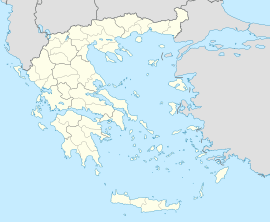Souroti facts for kids
Quick facts for kids
Souroti
Σουρωτή
|
|
|---|---|

Central square of Souroti
|
|
| Country | Greece |
| Administrative region | Central Macedonia |
| Regional unit | Thessaloniki |
| Municipality | Thermi |
| Municipal unit | Vasilika |
| Elevation | 120 m (390 ft) |
| Population
(2021)
|
|
| • Total | 1,583 |
| Time zone | UTC+2 (EET) |
| • Summer (DST) | UTC+3 (EEST) |
| Postal code |
570 06
|
| Area code(s) | 23960 |
| Vehicle registration | N |
Souroti (pronounced Soo-ro-tee) is a small village in Greece. It's about 25 kilometers (15 miles) away from the big city of Thessaloniki. Souroti is famous for its special mineral water. This water is bottled right in the village! It's part of a larger area called Thermi. You can also find the Monastery of Saint John the Theologian here. This monastery is linked to a well-known religious figure from the 20th century, St. Paisios.
Contents
A Look at Souroti's Past
Souroti is a village built by people who moved there from other places. Many villages like it were created in Greek Macedonia after the Balkan wars. This was also after a big event called the population exchange between Greece and Turkey. Before 1912, the area was known as "Surukli." This name came from a Turkish word meaning "herd." At that time, five Turkish landowners owned the land. They later sold it to Jewish people from Thessaloniki.
First Settlers
The first Greek family to settle in Souroti was the Christos Lolas family. They were Vlachs from a place called Vlasti. Even though they were shepherds, they sold their sheep to buy land from the Jewish owners. Their main job became sericulture, which is raising silkworms to make silk. They moved to Souroti because there were many mulberries there, which silkworms love to eat. They also traded silk with Jewish producers in Thrace.
New Families Arrive
In 1922, after the population exchange between Greece and Turkey, about 48 families arrived. They came from different parts of Asia Minor, like İzmir, Aydın, Cius, and Mudanya. Some also came from Eastern Thrace. These new families were educated and brought their own traditions. In Souroti, they continued to work in sericulture and also started making olive oil and growing grapes for wine. Between 1928 and 1930, more Vlach shepherds came from Vlasti. A few families of Sarakatsanoi (another group of shepherds) also arrived. The Greek government gave land to these new settlers in 1914 and again in 1932.
In October 1913, some Albanians from a village called Mandritsa also settled in Souroti. They moved there after their home village was invaded by Bulgarians.
How Souroti Became a Community
The community of Souroti was officially recognized by the Greek government on September 20, 1947. Since then, the village has grown steadily. Its main activities were farming and bottling mineral water. In 1997, the Greek government made big changes to how local areas were managed. This was called the "Kapodistrias plan." Souroti joined with the municipality of Vasilika and other nearby villages. Then, in 2011, with a new plan called Kallikratis, Vasilika joined with the municipality of Thermi. Today, people from nearby Thessaloniki are moving to the area around Souroti. It is expected to become a suburb of Thessaloniki.
The Famous Mineral Water Spring
Long ago, when the area was part of the Ottoman Empire, the land where the bottling factory is now was a swamp. No one knew about the mineral water spring. During First World War in 1915, French soldiers camped in the area, then called Surukli. They found the spring and built a simple place to bottle the water. In 1917, Serbian soldiers camped there and built a new bottling facility. They called the water "Sour Water."
The Lolas family took over and fixed up the facility in 1918. In 1925, a man named George Chonaios took over the business. He ran it as a private company, but he gave 5% of the money earned to the local community. In 1998, the company became public, meaning people could buy shares in it. Since then, it has grown very fast. It is now one of the most popular mineral water brands in Greece.
What Makes Souroti Water Special?
Souroti water is known as a sparkling mineral water. It is rich in important minerals like calcium and magnesium. The European Union also lists it as a recognized natural mineral water. A long time ago, in the early 1900s, the water was naturally sparkling. Today, it still has its original minerals, but carbon dioxide is added during bottling to make it bubbly.
The water comes from about 150 meters (nearly 500 feet) underground. Its excellent quality comes from the rocks of Mount Anthemounta. As the water slowly moves through these rocks, it gets filtered. It also picks up beneficial elements, which give it its unique taste and mineral makeup. The water from the spring is always cold, around 16 degrees Celsius (61 degrees Fahrenheit).
Souroti water has a lot of magnesium and a good balance of calcium to magnesium. It is also low in sodium and nitrate. It contains other helpful elements like potassium, fluorine, iron, copper, manganese, lithium, selenium, chromium, and zinc. It tastes great and is good for your body. It helps your digestive and urinary systems work well. Just one liter of Souroti water gives you a quarter of the calcium and magnesium your body needs each day! This makes it very different from soda water, which is just regular water with added baking soda to make it bubbly.


